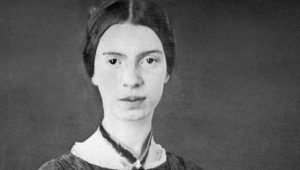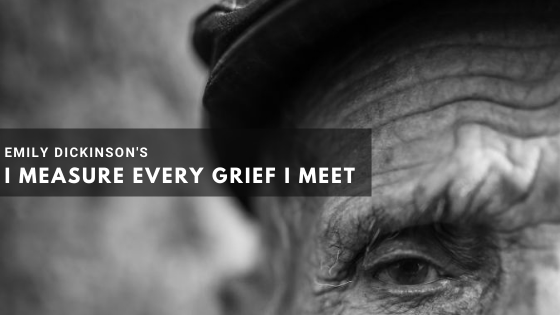I Measure Every Grief I Meet – The Poem
I measure every Grief I meet
With narrow, probing, Eyes —
I wonder if It weighs like Mine —
Or has an Easier size.
I wonder if They bore it long —
Or did it just begin —
I could not tell the Date of Mine —
It feels so old a pain —
I wonder if it hurts to live —
And if they have to try —
And whether — could They choose between —
It would not be — to die —
I note that Some — gone patient long —
At length, renew their smile —
An imitation of a Light
That has so little Oil —
I wonder if when Years have piled —
Some Thousands — on the Harm —
That hurt them early — such a lapse
Could give them any Balm —
Or would they go on aching still
Through Centuries of Nerve —
Enlightened to a larger Pain —
In Contrast with the Love —
The Grieved — are many — I am told —
There is the various Cause —
Death — is but one — and comes but once —
And only nails the eyes —
There’s Grief of Want — and Grief of Cold —
A sort they call “Despair” —
There’s Banishment from native Eyes —
In sight of Native Air —
And though I may not guess the kind —
Correctly — yet to me
A piercing Comfort it affords
In passing Calvary —
To note the fashions — of the Cross —
And how they’re mostly worn —
Still fascinated to presume
That Some — are like My Own —
Measuring the Greif – My Take
I am pretty sure we all have met someone who has told this to you. Especially young people get to hear a lot “You are born with a silver spoon. Your parents have taken care of everything you need. Our lives were not that easy. We lived back in time when the whole colony had a single tap of water. And that we had to carry the water to our homes from the center ground of the colony” Some of us have heard the stories about the times when our ancestors were caught in the middle of a “civil war” or when there was “no electricity”. To this, most of us laugh and say, “maybe you are right! Even our broadband gives a speed of 100 Mbps”. Our struggles, our pain, our grief is absolutely nothing compared to theirs.
But that’s not the end of the story. At that very moment, the neurotransmitters send some kind of signals to our brain. And you start having the flashes of all the sufferings you’ve had, all the pains that you’ve suffered, all the grief you’ve had so far in your life. All the times you have been bullied, the times when your loved ones left you, all the times you’ve stressed to the level of bursting, all the times you had panic attacks or nervous breakdowns. Whenever such a thing happens you start measuring every grief you’ve ever met.
But should you measure every grief you meet? Just because you are good with your calculations doesn’t mean you should start measuring every grief you meet. Having to go through it was already very painful, why count it again and reactivate its intensity.
Emily Dickinson
Emily Elizabeth Dickinson (December 10, 1830 – May 15, 1886) was an American poet.

Dickinson was born in Amherst, Massachusetts, into a prominent family with strong ties to its community. After studying at the Amherst Academy for seven years in her youth, she briefly attended the Mount Holyoke Female Seminary before returning to her family’s house in Amherst.
Evidence suggests that Dickinson lived much of her life in isolation. Considered an eccentric by locals, she developed a penchant for white clothing and was known for her reluctance to greet guests or, later in life, to even leave her bedroom. Dickinson never married, and most friendships between her and others depended entirely upon correspondence.
While Dickinson was a prolific poet, only 10 of her nearly 1,800 poems were published during her lifetime. The poems published then were usually edited significantly to fit conventional poetic rules. Her poems were unique to her era. They contain short lines, typically lack titles, and often use slant rhyme as well as unconventional capitalization and punctuation. Many of her poems deal with themes of death and immortality, two recurring topics in letters to her friends.
To read more about Emily Dickinson, click here.
Poem Analysis
This is an extremely sad poem, much like the life of Emily Dickinson. A poem about her appraisal of the sadness and grief that she meets, and I bet she meets many. This poem just keeps getting sad until the last couple of paragraphs, where she reveals that other’s grief gives her comfort. It is others too, who have suffered. And some of the pains are like hers. Here’s an explanation of different paragraphs of the poem:
Stanza 1:
In this stanza, she begins by stating that she is well observant of all the grief that she meets. And that she is keenly observing and weighing the same.
Stanza 2:
In this stanza, she talks about the age of her grief, vis-à-vis the age of other’s grief. To her, her grief seems very old the way she is acquainted with it.
Stanza 3:
This keeps getting sadder now. She wonders how worse other people’s pain is. That if they had an option, would they choose to live or rather die?
Stanza 4:
Some people had been through this for so long that they have accepted their grief. They have, sort of, put a smile to cover it up. But she questions the genuineness of the smile.
Stanza 5:
Emily Dickinson wonders if the time would heal the pain. Or, if at all times heals all the pain, where is all that time that heals?
Stanza 6:
This is a continuation of the previous stanza. Will the time heal, or expose them to an even larger pain? Wait, what? Is she calling love the biggest grief?
Stanza 7:
Now she goes back to the cause of the grief, which is many. She says death is one of them, but it isn’t that grave. Maybe she is talking about one’s own death only because otherwise there could be more than one death that you may witness (of your loved ones).
Stanza 8:
Then she talks about other griefs, maybe this time about the ones caused due to losing the loved ones.
Stanza 9:
This paragraph is a bit eerie. Here, with her brutal honesty, she talks about the comfort she gets by seeing other’s grief.
Stanza 10:
In the last stanza, she talks about the symbol of ultimate pain and grief, i.e. the cross on which Jesus was crucified. And also, how some of the pains are so relatable, that they feel like her own.
To read more famous poems by the finest writers ever, click here.








Beautiful poem.. though I can’t measure grief, the process is devastating.
Beautiful poem!
I agree with you that we should not measure every grief, but sometimes it’s very difficult to control one’s mind, we can’t help but wonder what grief is to others, and do they respond to it like us.